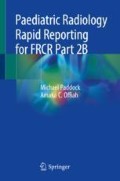Abstract
Children under the age of 1 year, and in particular less than 4 months, have the highest incidence of metaphyseal and abusive fractures. CMLs are less common in older, more ambulant children. In the presence of CMLs, there is a strong association with further abusive fractures identified on the skeletal survey which is why identification of these fractures is paramount. The distal femur, proximal and distal tibia, and proximal humeri are the commonest locations for metaphyseal fractures.
Access this chapter
Tax calculation will be finalised at checkout
Purchases are for personal use only
Preview
Unable to display preview. Download preview PDF.
Further Reading
Image 2
Dwek JR (2011) The radiographic approach to child abuse. Clin Orthop Relat Res 469(3):776–789
Lonergan GJ, Baker AM, Morey MK et al (2003) From the archives of the AFIP. Child abuse: radiologic-pathologic correlation. Radiographics 23(4):811–845
Image 6
Davidoff AM, Heaton TE (2016) Surgical treatment of metastases in pediatric solid tumors. Semin Pediatr Surg 25(5):311–317
Image 8
Craig FW, Schunk JE (2003) Retropharyngeal abscess in children: clinical presentation, utility of imaging, and current management. Pediatrics 111(6):1394–1398
Gaillard F et al (2018) Lemierre syndrome. https://radiopaedia.org/articles/lemierre-syndrome. Accessed April 2018
Knipe H, Babu AS et al (2018) Grisel syndrome. https://radiopaedia.org/articles/grisel-syndrome-2. Accessed April 2018
Knipe H, Hacking C et al (2018) Pseudosubluxation of the cervical spine. https://radiopaedia.org/articles/pseudosubluxation-of-the-cervical-spine. Accessed April 2018
National Institute for Health and Care Excellence (2014) ‘Head injury’, NICE clinical guideline 176. National Clinical Guideline Centre, London. https://www.nice.org.uk/guidance/cg176. Algorithm 4: selection of children from imaging of the cervical spine. https://www.nice.org.uk/guidance/cg176/resources/imaging-algorithm-pdf-498950893. Accessed April 2018
O’Brien TW Sr, Shen P, Lee P (2015) The dens: normal development, developmental variants and anomalies, and traumatic injuries. J Clin Imaging Sci 30(5):38
St-Amant M, Gaillard F et al (2018) Hangman fracture. https://radiopaedia.org/articles/hangman-fracture. Accessed April 2018
Swischuk LE (1977) Anterior displacement of C2 in children: physiologic or pathologic. Radiology 122(3):759–763
Image 10
Fitzpatrick KA, Taljanovic MS, Speer DP et al (2004) Imaging findings of fibrous dysplasia with histopathologic and intraoperative correlation. AJR Am J Roentgenol 182(6):1389–1398
Knipe H, Gaillard F et al (2018) McCune-Albright syndrome. https://radiopaedia.org/articles/mccune-albright-syndrome. Accessed April 2018
Yongjing G, Huawei L, Zilai P et al (2001) McCune-Albright syndrome: radiological and MR findings. JBR-BTR 84(6):250–252
Image 19
Al Khatib N, Younis MH, Hegazy A et al (2018) Early versus late treatment of paediatric femoral neck fractures: a systematic review and meta-analysis. Int Orthop 2018. https://doi.org/10.1007/s00264-018-3998-4 [Epub ahead of print]
Image 20
Di Muzio D, Weerakkody Y (2018) Askin tumour. https://radiopaedia.org/articles/askin-tumour-1. Accessed July 2018
Sharma R, Gaillard F et al (2018) Ewing sarcoma. https://radiopaedia.org/articles/ewing-sarcoma. Accessed April 2018
Tatco V, Amini B et al (2018) Codman triangle periosteal reaction. https://radiopaedia.org/articles/codman-triangle-periosteal-reaction. Accessed April 2018
Image 21
Knipe H, Hacking C et al (2018) Pseudosubluxation of the cervical spine. https://radiopaedia.org/articles/pseudosubluxation-of-the-cervical-spine. Accessed April 2018
Swischuk LE (1977) Anterior displacement of C2 in children: physiologic or pathologic. Radiology 122(3):759–763
Image 23
Hui C, Joughin E, Goldstein S et al (2008) Femoral fractures in children younger than three years: the role of nonaccidental injury. J Pediatr Orthop 28:297e302
Kemp AM, Dunstan F, Harrison S et al (2008) Patterns of skeletal fractures in child abuse: systematic review. BMJ 337:a1518
Paddock M, Sprigg A, Offiah AC (2017) Re: Imaging and reporting considerations for suspected physical abuse (non-accidental injury) in infants and young children. Part 1: initial considerations and appendicular skeleton. A reply. Clin Radiol 72(5):422
Image 28
McAloon J, O’Neill C (2011) Ossification centres, not rib fractures. Arch Dis Child 96(3):284
Image 30
Berdon WE, Willi U (2004) Situs inversus, bronchiectasis, and sinusitis and its relation to immotile cilia: history of the diseases and their discoverers-Manes Kartagener and Bjorn Afzelius. Pediatr Radiol 34(1):38–42
Knipe H, Wahba M et al (2018) Kartagener syndrome. https://radiopaedia.org/articles/kartagener-syndrome-1. Accessed April 2018
Author information
Authors and Affiliations
Rights and permissions
Copyright information
© 2019 Springer Nature Switzerland AG
About this chapter
Cite this chapter
Paddock, M., Offiah, A.C. (2019). Test 3. In: Paediatric Radiology Rapid Reporting for FRCR Part 2B. Springer, Cham. https://doi.org/10.1007/978-3-030-01965-5_3
Download citation
DOI: https://doi.org/10.1007/978-3-030-01965-5_3
Published:
Publisher Name: Springer, Cham
Print ISBN: 978-3-030-01964-8
Online ISBN: 978-3-030-01965-5
eBook Packages: MedicineMedicine (R0)

